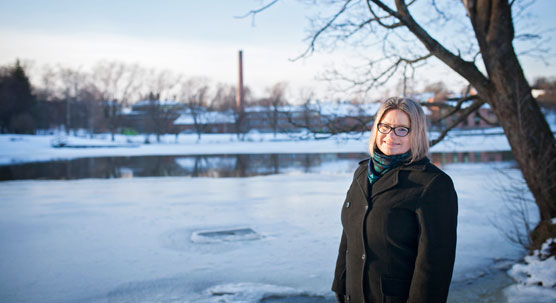Press release 2019-02-19 at 14:59

© Photo: Terhi Korhonen
The duration of the ice cover on Finnish inland waters has shortened due to milder winters. Correspondingly, the seasonal river discharges in winter and spring have increased, reports a new doctoral dissertation. Johanna Korhonen, Development Manager of the Finnish Environment Institute SYKE, studied the long-term changes and variability of the winter and spring season hydrological regime in Finland. Her doctoral dissertation will be examined at the University of Helsinki on 22 February.
“The changes in ice cover and the hydrological conditions in winter touch us in many ways, and they are of importance also on a global scale, particularly with a view to the radiation balance of the Earth. The research results can be applied to various planning and research purposes, such as water level regulation and hydroelectric power generation, flood risk management, recreational use of waters and biological and ecological research,” says Johanna Korhonen from SYKE.
Climate warming will have a major impact on seasonal winter and spring hydrology in Finland, as well as elsewhere on the boreal snow-driven regions. Research analyses show statistically significant long-term changes in both ice and discharge regime until recent years.
The duration of the ice cover has shortened, the ice freeze-up has become later and the ice break-up earlier
The dissertation studied long-term changes and variability of the winter and spring season hydrological regime based on long-term ice phenology and river discharge time series in Finland. The ice freeze-up has become later, and the ice break-up is earlier, while the duration of the ice cover has shortened. In recent decades, changes have become even more apparent, and the number of extremely early break-ups and late freeze-ups has increased.
“In ice phenology, new records have been set in the 21st century. In the 21st century, the freeze-ups have been later than average about on nine years out of ten. The average was calculated for the period 1961–2000. The break-ups were also earlier than average about on nine years out of ten.”
Some of the Northern and Central Finland observation sites had increasing maximum ice thickness trends until 2002, and decreasing trends were observed in the south. The maximum ice thickness time series, updated until the 2017–2018 winter, continue to show decreasing maximum ice thickness trends in the south, whereas no trends were present in Northern and Central Finland. “The ice thickness is also significantly affected by snow conditions, since a thick sub-zero snow cover has an insulating effect. During mild winters, snow also forms ‘snow ice’,” Korhonen explains.
Spring peak discharges have moved to an earlier date, and winter and spring discharges have increased
The river flow trend analysis until 2004 revealed an increase in winter and spring discharges and a trend towards an earlier spring peak discharge. The analysis revealed no changes in the mean annual flow or the spring high flow in general. Similar tendencies have even continued with updated data until the year 2017. These observed seasonal winter and spring hydrological trends are in line with findings of annual and seasonal air temperature and precipitation changes and also with projected climate change scenarios. The results of corresponding research studies conducted in other Nordic Countries show similar trends.
Atmospheric circulation patterns affect the hydrological regime
In addition to the analysis of long-term changes, the dissertation also investigated whether there was a connection between atmospheric circulation patterns and seasonal discharge conditions in winter and spring. Both the snow cover and river discharges are linked with atmospheric circulation patterns and they occur in cycles of varying lengths. The most significant phenomenon affecting Finland is the North Atlantic Oscillation (NAO), which explains the annual weather variation in the North Atlantic region. The influence of the NAO can be seen in both the ice and discharge time series. The strong positive winter NAO is related to shorter ice cover duration and higher winter discharges, and the strong negative winter NAO vice versa.
The long Finnish time series are unique in global scale
The long-term Finnish hydrological time series used for the dissertation are unique in the global scale. Ice cover and river discharge observations are among the oldest hydrological records in Finland, and in some locations records cover 150–300 years.
Even though models and remote sensing methods develop all the time, in-situ observations are needed particularly in support of the development of new methods and for the validation of long-term changes.
The hydrological time series can be downloaded for free in SYKE's open data service. The long-term Finnish time series are based on a vast amount of field surveying conducted by professionals in hydrology, accurate quality control at the office and careful observations made by voluntary citizens.
Further information
Ms Johanna Korhonen, Development Manager of the Finnish Environment Institute SYKE, tel. +358 295 251 302, firstname.surname@ymparisto.fi
The public defence of the dissertation will be held at the Faculty of Science of the University of Helsinki on the Kumpula campus on Friday 22 February 2019 at 12.
Address: Exactum, auditorium B123, Gustaf Hällströmin katu 2B, Helsinki
Academic dissertation in geophysics: Long-term changes and variability of the winter and spring season hydrological regime in Finland